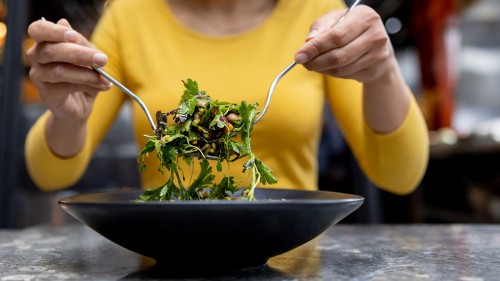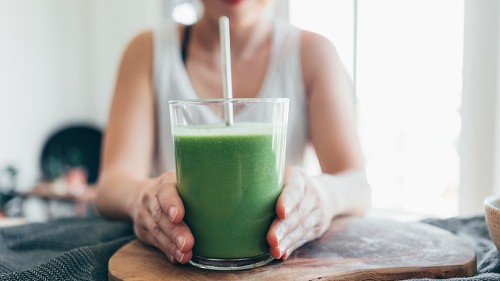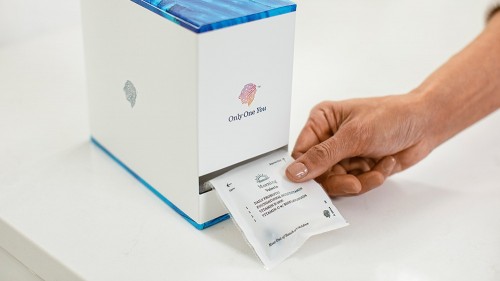Dietitian Shares 15 Foods High in Zinc and Easy Ways to Include Them in Your Diet
Published on October 27, 2021
Medically Reviewed by Anthony Dugarte, MD
Zinc doesn’t get quite as much attention as some of the other micronutrients, but that doesn’t mean it’s less critical for your health. This article offers 15 foods high in zinc, including suggestions for how to include them in your diet.


You may be most familiar with zinc in the form of throat lozenges or dissolvable tablets for when you feel a cold coming on.
However, getting enough zinc isn’t just important when you’re under the weather.
When zinc is lacking in your diet, it can increase your susceptibility to illness, such as more severe COVID-19 infections. (1, 2)
Still, signs of deficiency are nonspecific and can be challenging to identify.
Fortunately, there are plenty of foods you can include in your diet that can help make sure you’re regularly meeting your zinc needs.
Why Do We Need Zinc?
Zinc is an essential mineral needed for over 300 enzymatic reactions to occur regularly in your body. (3, 4)
These are involved in things like your immune function, wound healing, DNA synthesis, cellular division, and the process of making proteins. (5)
Part of the reason zinc has such a vital role in the immune system is its antioxidant and anti-inflammatory activity. (6)
Getting enough zinc is also necessary for your senses of taste and smell to function normally. It may also help protect your eyes from age-related disease progression. (7, 8)
Zinc is not stored in your body, so this means that you have to get some of it daily to maintain your requirements, which are around 8–11 mg per day for average healthy adults. (3, 9)
Incorporating zinc-rich foods into your diet is a great way to do so.
15 Foods High in Zinc
The following are 15 examples of good zinc foods. Plus, they have the added benefit of being easy to use, and several of them likely already have a place in your current lifestyle.
1. Seeds
Seeds are one of the most accessible vehicles to add zinc to your diet.
One ounce (28 grams) of roasted pumpkin seeds offers 3 mg of zinc, or 19% of the Daily Value (DV) for zinc. (10)
The same serving size of hemp seeds contains 3.75 mg of zinc, or 25% of your DV. Chia, flax, and sunflower seeds contain some zinc, approximately 1–2 mg per ounce. (11)
Put It Into Action
- Add seeds to your smoothies, sprinkle them on your oatmeal or yogurt bowls, blend them into hummus, or toss them into a mixed green salad.
- Seeds are, of course, also tasty on their own, included in homemade granola or trail mix, and even mixed into oatmeal chocolate chip cookie batter.
- They also work well sprinkled into avocado toast.
2. Yogurt
One cup (8 ounces) of plain non-fat yogurt will contribute around 2.2 mg of zinc, or 15% of the DV for zinc. While dairy is a good source of zinc, non-dairy alternatives generally are not. (12)
Put It Into Action
- Enjoy yogurt as a base for a hearty fruit, nut, and granola bowl.
- Add a dollop of it to your smoothies.
- Use it to make a yogurt dip or dressing.
- Add a bit of plain unsweetened yogurt to pancake and waffle batter.
3. Chickpeas
Also known as garbanzo beans, chickpeas contain 2.5 mg of zinc, or 17% of your DV, per cup. (13)
You can purchase them dried (like other beans) to soak and cook or buy them in canned form.
Put It Into Action
- Chickpeas are a surprisingly good plant-based substitute for canned chicken.
- You can mash them with a fork and use them to make chickpea salad sandwiches or baked chickpea nuggets.
- They also work well roasted in the oven until crispy as a snack or salad topper.
4. Lentils
Lentils come in a variety of colors, including red, green, brown, and even black. You can buy them dried and in bulk, or canned.
A one-cup (198 gram) serving of cooked lentils offers 2.5 mg of zinc, or 17% of the DV for zinc. (14)
Put It Into Action
- Enjoy lentils warm in soups and dahls, cold on salads, or as a plant-based substitute to make sloppy joes or chilis.
- You can even use lentils to make lentil loaf, a vegan meatloaf alternative.
5. Mushrooms
There are many varieties of edible mushrooms, several of which you can easily find at most supermarkets.
Just four cooked shiitake mushrooms, or a cup of sliced portabellos, offer 1 mg of zinc, or 6% of your DV. (15, 16)
If you like sauteed white button mushrooms, they still contain around 4% of your DV in a one-cup serving. (17)
Put It Into Action
- Mushrooms can be sliced and served raw over a mixed green salad.
- They can be cooked as part of a veggie stir-fry, added to an omelet or breakfast scramble, diced and made into veggie meatballs or plant-based burger patties.
- Mushrooms can even be stuffed and roasted in the oven.
6. Nuts
While you’re boosting your seed intake, you might as well add some nuts into the mix.
Some of the most zinc-rich nuts include cashews, pine nuts, pecans, and almonds. These contribute 11%, 12%, 8%, and 7% of the DV for zinc per ounce (28 grams), respectively.
Put It Into Action
- Nuts make a great snack on their own, as part of a snack mix, inside or on top of pancakes and waffles, in salads and pasta dishes, or even added to smoothies.
- It’s super easy to make your own nut butter at home, too – just add nuts to a high-speed blender or food processor and blend until smooth.
7. Meat and Poultry
If you consume animal products, meats like chicken, lamb, beef, and pork are generally good sources of zinc.
One cup (140 grams) of diced roasted chicken breast offers around 1.4 mg of zinc, or 9% of the DV for zinc. (18)
A 3 ounce (85 gram) serving of cooked, trimmed beef will offer a whopping 5 mg of zinc, or 34% of the DV. (19)
Put It Into Action
- Meat and poultry can be baked, roasted, sliced into sandwiches, sauteed in stir-fries.
- They can also be used in pasta dishes, salads, soups, and stews.
8. Avocado
One whole avocado will provide around 1.2 mg of zinc, or 8% of the DV for zinc. This might sound like a big serving, but a whole avocado can be used in many ways. (20)
Put It Into Action
- Avocado toast is a favorite breakfast for many families, topped with things like sliced tomatoes and onions, nuts, and seeds.
- You can mash avocado inside tortillas to make tacos, make tangy guacamole, add avocado chunks to salads, and on top of soups.
- You can even roll them in breadcrumbs and roast them.
9. Eggs
One average egg contains around 2.7 mg of zinc, or 18% of your DV for zinc. (21)
Put It Into Action
- You can eat eggs scrambled, hard-boiled, poached over toast, or as part of batters to make bread, muffins, pancakes, and waffles.
- If hard-boiled, try slicing it over salads or dicing it to make an egg salad sandwich.
10. Cocoa Powder
This might come as a surprising suggestion, but cocoa powder can be added to your diet in several ways.
Plus, just two tablespoons (10 grams) of unsweetened cocoa powder provides 4% of the DV for zinc. (22)
If you’re not a fan of cocoa powder, dark chocolate bars also provide this mineral. One dark chocolate candy bar (100 grams) that contains 70–85% cacao will meet 22% of your DV for zinc. (23)
Put It Into Action
- Use cocoa powder to make brownies or chocolate cake from scratch, a creamy mug of hot cocoa, or even in savory recipes like cocoa veggie burgers and chilis.
- You might even like a tablespoon of cocoa powder with peanut butter mixed into your oatmeal.
11. Shellfish
Shellfish refers to crustaceans and mollusks that have a hard outer shell or exoskeleton. This includes things like crabs, crawfish, and shrimp, but the most zinc-rich option is the oyster.
In fact, one medium oyster contains nearly 55% of your DV for zinc, coming in at around 8.3 mg each. (24)
Put It Into Action
The optimal way to eat oysters is to:
- Purchase them fresh
- Consume the flesh inside
- Discard the shell
12. Whole Grains
Whole grains are a great source of zinc, particularly varieties like wheat, quinoa, oats, and brown rice.
Note that grains and legumes contain compounds called phytates that can bind to minerals like zinc and reduce their absorption. (25)
This isn’t a cause for alarm or reason to avoid grains and legumes; it just means they shouldn’t be the only source of zinc in your diet.
One half-cup (90 grams) of cooked quinoa provides 1 mg of zinc, or 7% of the DV for zinc. (26)
A half-cup (75 grams) of oats offers an impressive 3 mg of zinc, or over 20% of your DV for the nutrient. (27)
Put It Into Action
Enjoy whole grains:
- As a base for cooked veggies and protein foods
- In homemade veggie burger patties
- As part of a warm salad or soup
- For breakfast
- Served with cooked greens as a side dish
13. Potatoes
While not all vegetables are a good source of zinc, potatoes offer some. One large white potato with its skin intact provides around 7% of your DV for zinc, or over 1 mg. (28)
One cup (200 grams) of baked sweet potato provides slightly less, coming in at around 4% of your DV for zinc. (29)
Put It Into Action
- Potatoes are delicious stuffed with broccoli and cheese and roasted in the oven.
- You can prepare them in an air fryer to make homemade chips, or cut them into matchsticks and bake them until crispy.
- Sauté or boil potato cubes and add them to soups and stews.
- You can also make mashed potatoes with both varieties, depending on whether you want a sweet or savory dish.
14. Cheese
Just like yogurt, cheese is a good source of bioavailable zinc. For example, a single slice of cheddar cheese offers 6% of the DV for zinc, or approximately 1 mg. (30, 31)
Unfortunately, keep in mind that plant-based cheese alternatives are generally not a good source of this nutrient (although you could make your own zinc-rich cheese sauce using cashews!).
Put It Into Action
- Cheese is one of the world’s most beloved foods, and there are plenty of ways to enjoy it.
- The many varieties of cheese can be eaten in sandwiches, to top soups, stews, and salads, in burritos and enchiladas, on pizza, in quesadillas, or on their own as part of an afternoon snack.
15. Soybeans
One cup (172 grams) of cooked soybeans (also called edamame) provides 13% of the DV for zinc, or approximately 2 mg. (32)
Put It Into Action
- You can add cooked soybeans to whole grain dishes, blend them into homemade veggie burger patties, add to stir-fries with thick pasta noodles, mix into soups, or blend into an edamame hummus
- You can also eat cooked soybeans on their own, seasoned with a bit of salt.
The Bottom Line
Adding more zinc to your diet can be as simple as adding more nuts and seeds, trying some new breakfast creations, or learning to incorporate some more legumes into your rotation.
Zinc deficiency can have a variety of nonspecific symptoms and be difficult to identify, so it’s a good idea to eat in a way that helps prevent that from happening in the first place.
If you haven’t been paying much attention to your zinc intake outside of cold and flu season, try eating more of the foods with zinc listed above to make sure you get enough of this essential nutrient all year round.
At WellnessVerge, we only use reputable sources, including peer-reviewed medical journals and well-respected academic institutions.
- Zinc deficiency:
https://pubmed.ncbi.nlm.nih.gov/19528881/ - Zinc deficiency as a possible risk factor for increased susceptibility and severe progression of Corona Virus Disease 19:
https://pubmed.ncbi.nlm.nih.gov/33641685/ - National Institutes of Health: Zinc:
https://ods.od.nih.gov/factsheets/Zinc-HealthProfessional/ - Discovery of human zinc deficiency: its impact on human health and disease:
https://pubmed.ncbi.nlm.nih.gov/23493534/ - The Role of Zinc in Antiviral Immunity:
https://pubmed.ncbi.nlm.nih.gov/31305906/ - Antioxidant and anti-inflammatory effects of zinc. Zinc-dependent NF-κB signaling:
https://pubmed.ncbi.nlm.nih.gov/28083748/ - Zinc and Taste Disturbances in Older Adults: A Review of the Literature:
https://pubmed.ncbi.nlm.nih.gov/27178656/ - A systematic review on zinc for the prevention and treatment of age-related macular degeneration:
https://pubmed.ncbi.nlm.nih.gov/23652490/ - Zinc: a multipurpose trace element:
https://pubmed.ncbi.nlm.nih.gov/16187101/ - Seeds, pumpkin and squash seeds, whole, roasted, without salt Nutrition Facts & Calories:
https://nutritiondata.self.com/facts/nut-and-seed-products/3141/2 - U.S. Department of Agriculture, Agricultural Reaseach Center: Organic Hemp Seeds:
https://fdc.nal.usda.gov/fdc-app.html#/food-details/1834435/nutrients - Yogurt, plain, low fat, 12 grams protein per 8 ounce Nutrition Facts & Calories:
https://nutritiondata.self.com/facts/dairy-and-egg-products/105/2 - Chickpeas (garbanzo beans, bengal gram), mature seeds, canned Nutrition Facts & Calories:
https://nutritiondata.self.com/facts/legumes-and-legume-products/4327/2 - Lentils, mature seeds, cooked, boiled, without salt Nutrition Facts & Calories:
https://nutritiondata.self.com/facts/legumes-and-legume-products/4338/2 - Mushrooms, shiitake, cooked, without salt Nutrition Facts & Calories:
https://nutritiondata.self.com/facts/vegetables-and-vegetable-products/2488/2 - Mushrooms, portabella, grilled [Portobello] Nutrition Facts & Calories:
https://nutritiondata.self.com/facts/vegetables-and-vegetable-products/9170/2 - Mushrooms, white, stir-fried Nutrition Facts & Calories:
https://nutritiondata.self.com/facts/vegetables-and-vegetable-products/9171/2 - Chicken, broilers or fryers, breast, meat only, cooked, roasted Nutrition Facts & Calories:
https://nutritiondata.self.com/facts/poultry-products/703/2 - Beef, composite of trimmed retail cuts, separable lean and fat, trimmed to 1/8" fat, choice, cooked Nutrition Facts & Calories:
https://nutritiondata.self.com/facts/beef-products/3672/2 - Avocados, raw, Florida Nutrition Facts & Calories:
https://nutritiondata.self.com/facts/fruits-and-fruit-juices/1845/2 - Egg, whole, raw, fresh Nutrition Facts & Calories:
https://nutritiondata.self.com/facts/dairy-and-egg-products/111/2 - Cocoa, dry powder, unsweetened Nutrition Facts & Calories:
https://nutritiondata.self.com/facts/sweets/5471/2 - Candies, chocolate, dark, 70-85% cacao solids Nutrition Facts & Calories:
https://nutritiondata.self.com/facts/sweets/10638/2 - Mollusks, oyster, Pacific, cooked, moist heat Nutrition Facts & Calories:
https://nutritiondata.self.com/facts/finfish-and-shellfish-products/4253/2 - Reduction of phytic acid and enhancement of bioavailable micronutrients in food grains:
https://www.ncbi.nlm.nih.gov/pmc/articles/PMC4325021/ - Quinoa, cooked Nutrition Facts & Calories:
https://nutritiondata.self.com/facts/cereal-grains-and-pasta/10352/2 - Oats Nutrition Facts & Calories:
https://nutritiondata.self.com/facts/cereal-grains-and-pasta/5708/2 - Potato, baked, flesh and skin, without salt Nutrition Facts & Calories:
https://nutritiondata.self.com/facts/vegetables-and-vegetable-products/2770/2 - Sweet potato, cooked, baked in skin, without salt [Sweetpotato] Nutrition Facts & Calories:
https://nutritiondata.self.com/facts/vegetables-and-vegetable-products/2667/2 - Zinc and its importance for human health: An integrative review:
https://www.ncbi.nlm.nih.gov/pmc/articles/PMC3724376/ - Cheese, cheddar Nutrition Facts & Calories:
https://nutritiondata.self.com/facts/dairy-and-egg-products/8/2 - Soybeans, mature cooked, boiled, without salt Nutrition Facts & Calories:
https://nutritiondata.self.com/facts/legumes-and-legume-products/4376/2






